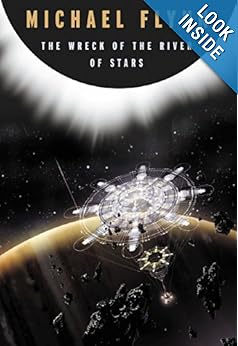Any time I am going out of town on business, I MUST buy a new book to read. The problem is, I rarely know in advance when I am heading out, which means I can't shop thrifty. Yep. Usually that means I buy a book from Barne's and Noble's the night before, or even worse...a book from the airport.
Anyway, what I have learned in the last few years is to review the reviews before purchase. There is a growing trend these days for writers to pump out mainstream literature that is a bid to make a dollar instead of a statement.
"The Wreck of the River of Stars" comes highly recommended on Amazon. Something like 50 reviewers since it's release early this year. Those reviewers score it as a 4 star. I was VERY wary of that.
Amazon.com Review
In his excellent novel The Wreck of The
River of Stars, Michael Flynn looks back on the romantic Age of Sail: the
second, high-tech Age of Sail, when spaceships with vast magnetic sails rode the
solar winds across the immense ocean of space, and the greatest of the luxury
spaceliners was The River of Stars. But the second Age of Sail is dead:
the magnetic sails all were struck, and the spaceships all were retrofitted with
the new Farnsworth fusion drive. Once a legend, The River of Stars is now
a tramp cargo freighter, plying the outer planets with a scanty crew of men and
women with questionable pasts, private agendas, and more than a little
interpersonal friction.
When a bizarre failure disables the Farnsworth engines driving The River
of Stars, the crew has a problem no Earthly sailor ever faced: their ports
don't stay put. If The River of Stars doesn't arrive on schedule, Jupiter
will be somewhere else in its enormous orbit. That means the damaged ship will
speed out of the solar system and drift forever among the stars. The crew's only
hope appears to be the magnetic sail. But recreating a long-gone high-tech sail
isn't the worst problem this motley crew faces. To survive, they must achieve
something even more herculean: they must overcome their own intricately
entangled fears, hatreds, power struggles, and romantic disasters. --Cynthia
Ward --
Zach's Review
This novel developed 14 characters, though many of those are not used much throughout the book. However, they are well described and the reader can easily understand them. The main characters, 9 or so, are extremely well developed. In particular, most of them are heroic, but not in the sense that most writers write their hero as infallible. On the contrary, every character has their flaws and those flaws are slowly shown and descried throughout the novel in small tid bits, like bread crumbs. I would say that Flynn does as good a job as I have ever read on the complete dissection and analysis of a character. Best of all, he doesn't spoon feed every character to the reader in a fire hose of information in the first chapter. It is a rare thing to understand a character so well that you can predict HOW they will react to a situation in a novel based upon the authors job of development.
Additionally, the intertwining of the characters lives, given the robust description and development, show the full dynamic among the crew, which is very unique.
These a substantial amount of science put into this novel should make any technical reader happy. Specifically, the science of orbital mechanics is a firm driver behind the plot of the entire piece of literature. Additionally, engineers especially will enjoy reading about the technical problems and their associated solutions that are faced on the ship. At all times, the reader is made well aware of the cause and effect of the environment of space and the ships behavior in it.
What I liked:
The writing style was very unique and well done. It is fairly advanced in its style, which causes readers to slow down and really comprehend every detail of the writing, lest something escape.
The characters are easy to understand and follow
The plot flows very well and is packed with multiple cause-and-effect plot drivers. Not just 1 or 2 hurdles to overcome, but a fault tree of situations.
There was a good amount of technical writing done
What I didn't like:
Beginning about the middle of the book, a sub-plot formulated itself very similar to 2001: A Space Odyssey which was easy to spot and predict.
Conclusion: 4 Stars
Overall, I greatly enjoyed this book. Despite the amount of shallow and pedantic literature that I have read in the last few years that has made me avoid ANY work written in the last 10 years, I believe the reviews were spot on about this book. Furthermore, I firmly believe that a non-sci-fi reader would really enjoy this work. I can't talk enough about the character development and the science ingrained in the the plot. This is one novel that I will put on the bookshelf at my office.


No comments:
Post a Comment